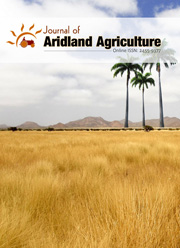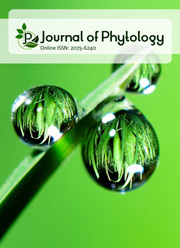Analysis of glucosinolate and phenylpropanoid contents in four different cultivars of radish sprouts
DOI:
https://doi.org/10.25081/jaa.2025.v11.9552Keywords:
Raphanus sativus, Growth performance, Phytochemical composition, Glucosinolates, PhenylpropanoidsAbstract
Radish (Raphanus sativus L.) is a prominent root vegetable cultivated throughout the world because of its nutritional and bioactive components. This study is conducted for growth performance and phytochemical investigation of four different cultivars of radish sprouts i.e., white, yellow, red, and black. Growth parameters such as shoot length, root length, and fresh weight were recorded and the results showed that the red cultivar had the highest values in all aspects, showing the highest shoot length (5.72 cm), root length (12.1 cm), and fresh weight (283.7 mg). In the black cultivar, these parameters exhibited the lowest growth. Individual glucosinolates (GSLs) and phenylpropanoid compounds were also analyzed from all the cultivars. The analysis of 10-day-old radish sprouts revealed the presence of 7 glucosinolates and 10 phenylpropanoid compounds. The individual and total content of all the compounds varied significantly within cultivars. The highest amount of total glucosinolates (87.00 μmol/g DW) was detected in red whereas the lowest total was found in the yellow cultivar (60.78 μmol/g DW). The variation of glucoraphanin content among the cultivars varied largely than any other glucosinolate showing much more in the red and white cultivars. The accumulation of glucoraphasatin content was much higher irrespective of cultivars. As for phenylpropanoids, the red cultivar exhibited the greatest amounts of chlorogenic acid (56.34 μg/g DW) and benzoic acid (42.35 μg/g DW). Among all cultivars, the white cultivar had the lowest phenylpropanoid profile, especially in terms of benzoic acid. This study reveals wide variation in growth and phytochemicals among the radish cultivars cultured on soil pots the positive traits of the red cultivar showed enhanced yield and nutraceutical compounds.
Downloads
References
Castro-Torres, I. G., De la O-Arciniega, M., Gallegos-Estudillo, J., Naranjo-Rodríguez, E. B., & Domínguez-Ortíz, M. Á. (2014). Raphanus sativus L. var niger as a source of phytochemicals for the prevention of cholesterol gallstones. Phytotherapy Research, 28(2), 167-171. https://doi.org/10.1002/ptr.4964
Ebert, A. W. (2022). Sprouts and microgreens-Novel food sources for healthy diets. Plants, 11(4), 571. https://doi.org/10.3390/plants11040571
Fraser, C. M., & Chapple, C. (2011). The phenylpropanoid pathway in Arabidopsis. The Arabidopsis Book, 2011(9), e0152. https://doi.org/10.1199/tab.0152
Fu, T., Stewart, D., Reineke, K., Ulaszek, J., Schlesser, J., & Tortorello, M. (2001). Use of spent irrigation water for microbiological analysis of alfalfa sprouts. Journal of Food Protection, 64(6), 802-806. https://doi.org/10.4315/0362-028X-64.6.802
Gancheva, M. S., Dodueva, I. E., Lebedeva, M. A., Tvorogova, V. E., Tkachenko, A. A., & Lutova, L. A. (2016). Identification, expression, and functional analysis of CLE genes in radish (Raphanus sativus L.) storage root. BMC Plant Biology, 16, 7. https://doi.org/10.1186/s12870-015-0687-y
Gao, L., Li, H., Li, B., Shao, H., Yu, X., Miao, Z., Zhang, L., Zhu, L., & Sheng, H. (2022). Traditional uses, phytochemistry, transformation of ingredients and pharmacology of the dried seeds of Raphanus sativus L. (Raphani Semen), A comprehensive review. Journal of Ethnopharmacology, 294, 115387. https://doi.org/10.1016/j.jep.2022.115387
Gutiérrez, R. M. P., & Perez, R. L. (2004). Raphanus sativus (Radish): their chemistry and biology. The Scientific World Journal, 4, 811-837. https://doi.org/10.1100/tsw.2004.131
Heng, S., Gao, C., Cui, M., Fu, J., Ren, S., Xin, K., He, C., Wang, A., Song, L., Tang, L., Wang, B., & Zhang, X. (2022). Metabolic and transcriptome analysis of dark red taproot in radish (Raphanus sativus L.). PLoS One, 17(5), e0268295. https://doi.org/10.1371/journal.pone.0268295
Kajszczak, D., Sosnowska, D., Frąszczak, B., & Podsędek, A. (2024). Composition, anti-diabetic, and antioxidant potential of Raphanus sativus leaves. Molecules, 29(23), 5689. https://doi.org/10.3390/molecules29235689
Korkina, L., Kostyuk, V., De Luca, C., & Pastore, S. (2011). Plant phenylpropanoids as emerging anti-inflammatory agents. Mini-Reviews in Medicinal Chemistry, 11(10), 823-835. https://doi.org/10.2174/138955711796575489
Li, X., Sathasivam, R., Park, N. I., Wu, Q., & Park, S. U. (2020). Enhancement of phenylpropanoid accumulation in tartary buckwheat hairy roots by overexpression of MYB transcription factors. Industrial Crops and Products, 156, 112887. https://doi.org/10.1016/j.indcrop.2020.112887
Manivannan, A., Kim, J.-H., Kim, D.-S., Lee, E.-S., & Lee, H.-E. (2019). Deciphering the nutraceutical potential of Raphanus sativus-A comprehensive overview. Nutrients, 11(2), 402. https://doi.org/10.3390/nu11020402
Martinez-Villaluenga, C., Peñas, E., Ciska, E., Piskula, M. K., Kozlowska, H., Vidal-Valverde, C., & Frias, J. (2010). Time dependence of bioactive compounds and antioxidant capacity during germination of different cultivars of broccoli and radish seeds. Food Chemistry, 120(3), 710-716. https://doi.org/10.1016/j.foodchem.2009.10.067
Márton, M., Mándoki, Z., Csapó-Kiss, Z., & Csapó, J. (2010). The role of sprouts in human nutrition. A review. Acta Universitatis Sapientiae, 3, 81-117.
Mitsui, Y., Shimomura, M., Komatsu, K., Namiki, N., Shibata-Hatta, M., Imai, M., Katayose, Y. , Mukai, Y. , Kanamori, H. , Kurita, K. , Kagami, T. , Wakatsuki, A. , Ohyanagi, H. , Ikawa, H. , Minaka, N. , Nakagawa, K. , Shiwa, Y., & Sasaki, T. (2015). The radish genome and comprehensive gene expression profile of tuberous root formation and development. Scientific Reports, 5, 10835. https://doi.org/10.1038/srep10835
Naoumkina, M. A., Zhao, Q., Gallego-Giraldo, L., Dai, X., Zhao, P. X., & Dixon, R. A. (2010). Genome-wide analysis of phenylpropanoid defence pathways. Molecular Plant Pathology, 11(6), 829-846. https://doi.org/10.1111/j.1364-3703.2010.00648.x
Ortiz, A., & Sansinenea, E. (2023). Phenylpropanoid derivatives and their role in plants' health and as antimicrobials. Current Microbiology, 80, 380. https://doi.org/10.1007/s00284-023-03502-x
Rates, A. B., & Cesarino, I. (2023). Pour some sugar on me: The diverse functions of phenylpropanoid glycosylation. Journal of Plant Physiology, 291, 154138. https://doi.org/10.1016/j.jplph.2023.154138
Sathasivam, R., Park, S. U., Kim, J. K., Park, Y. J., Kim, M. C., Nguyen, B. V., & Lee, S. Y. (2023). Metabolic profiling of primary and secondary metabolites in kohlrabi (Brassica oleracea var. gongylodes) sprouts exposed to different light-emitting diodes. Plants, 12(6), 1296. https://doi.org/10.3390/plants12061296
Tohge, T., & Fernie, A. R. (2017). An overview of compounds derived from the shikimate and phenylpropanoid pathways and their medicinal importance. Mini-Reviews in Medicinal Chemistry, 17(12), 1013-1027. https://doi.org/10.2174/1389557516666160624123425
Vidal-Valverde, C., Frias, J., Sierra, I., Blazquez, I., Lambein, F., & Kuo, Y.-H. (2002). New functional legume foods by germination: Effect on the nutritive value of beans, lentils and peas. European Food Research and Technology, 215, 472-477. https://doi.org/10.1007/s00217-002-0602-2
Yu, R., Wang, J., Xu, L., Wang, Y., Wang, R., & Zhu, X., Sun, X., Luo, X., Xie, Y., Everlyne, M., & Liu, L.(2016). Transcriptome profiling of taproot reveals complex regulatory networks during taproot thickening in radish (Raphanus sativus L.). Frontiers in Plant Science, 7, 1210. https://doi.org/10.3389/fpls.2016.01210
Zhang, J., Zhao, J., Tan, Q., Qiu, X., & Mei, S. (2021). Comparative transcriptome analysis reveals key genes associated with pigmentation in radish (Raphanus sativus L.) skin and flesh. Scientific Reports, 11, 11434. https://doi.org/10.1038/s41598-021-90633-5
Zheng, C., Hu, C., Ma, X., Peng, C., Zhang, H., & Qin, L. (2012). Cytotoxic phenylpropanoid glycosides from Fagopyrum tataricum (L.) Gaertn. Food Chemistry, 132(1), 433-438. https://doi.org/10.1016/j.foodchem.2011.11.017
Published
How to Cite
Issue
Section
Copyright (c) 2025 Thanh Vu Thach, Nam Su Kim, Hyewon Seo, Minhwan Lee, Haejin Kwon, Md Romij Uddin, Chanung Park, Sang Un Park

This work is licensed under a Creative Commons Attribution-NonCommercial 3.0 Unported License.





 .
.